Sphinx Kalmiae, the Laurel Sphinx
Sphinx kalmiae
SfinksmKAL-me-ay
J. E. Smith, 1797
Laurel Sphinx
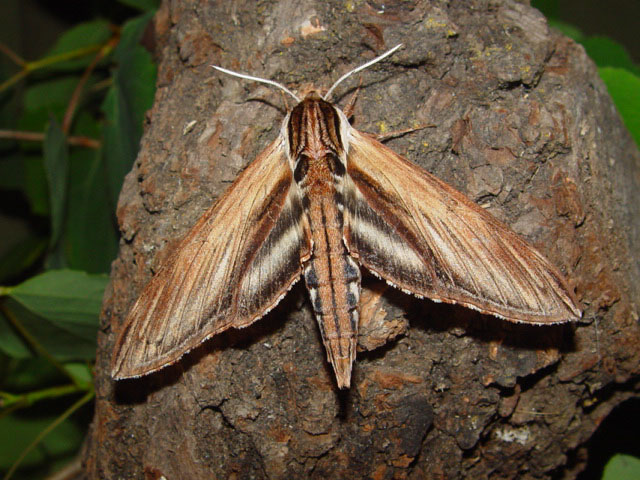
Sphinx kalmiae,
June 16, 2005, Peterborough, Ontario, courtesy of Tim Dyson.
This site has been created by
Bill Oehlke at oehlkew@islandtelecom.com
Comments, suggestions and/or additional information,
especially sightings, are welcomed by Bill.
TAXONOMY:
Family: Sphingidae, Latreille, 1802
Subfamily: Sphinginae, Latreille, 1802
Tribe: Sphingini, Latreille, 1802
Genus: Sphinx Linnaeus, 1758
Species: kalmiae J. E. Smith, 1797........
|
MIDI MUSIC
......It's a Wonderful World......
copyright C. Odenkirk
ON.OFF
<bgsound src="world.mid" LOOP=FOREVER>
|
DISTRIBUTION:
Sphinx kalmiae,
the Laurel Sphinx (tongue length 40 mm), is found in the eastern third
of North America from the maritime provinces to northern Florida.
It ranges further to the west in Canada and has been confirmed in
Saskatchewan. Georgia is the specimen type locality.
The lower forewings are predominantly brownish-yellow with a
fairly wide dark bar along the inner margin. At rest the wings hug the body, giving the moth a long slender look.
Both males and females come to lights on Prince
Edward Island, Canada. Sphinx kalmiae Peterborough, Ontario,
June 13, 2005, courtesy of Tim Dyson. | 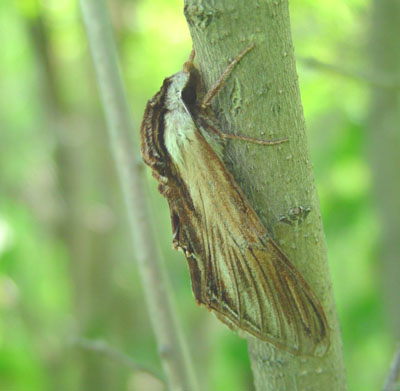 |
FLIGHT TIMES:In Canada, Sphinx
kalmiae is single-brooded with most adults on the wing in June
and July. In New Jersey and Connecticut and states of that
latitiude, the Laurel Sphinx is double-brooded (late May-June flight
and then again in July-August).
There are as many as six broods in Louisiana with the first brood appearing in early to mid April.Here on P.E.I. I tend to see
kalmiae (mostly males) at lights in July and early August.
Sphinx kalmiae Peterborough, Ontario,
June 13, 2005, courtesy of Tim Dyson.
The underside ground colour is an even, drab gray-brown with some
dark markings. The specimen to the right is somewhat worn.
| 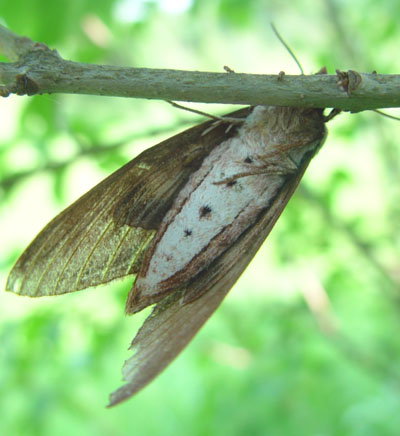 |
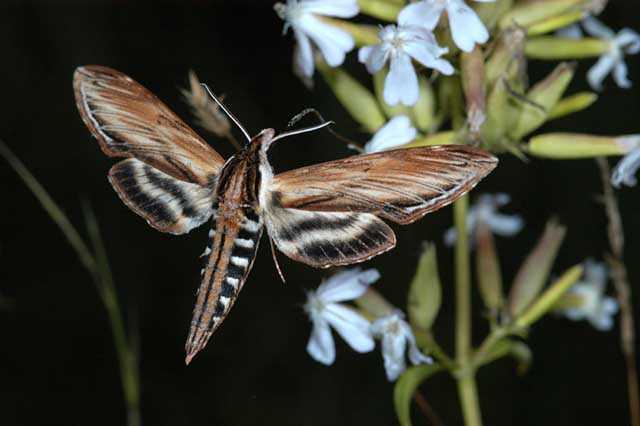
Sphinx kalmiae nectaring at bouncing bet, Flatbrookville, Sussex County, New Jersey,
July 2008, courtesy of Jeff Swick.
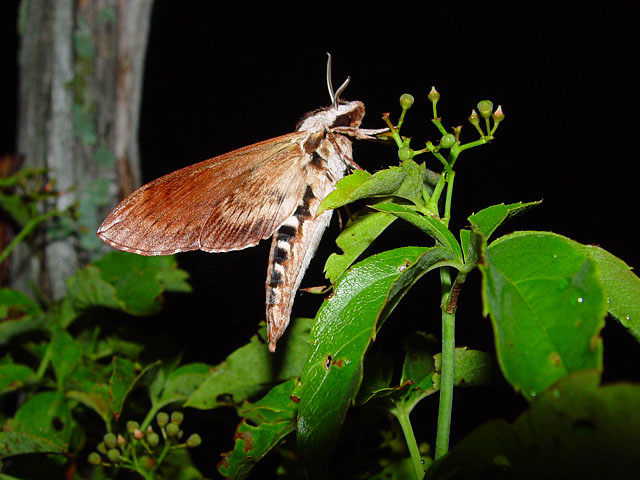
Sphinx kalmiae undersides, Peterborough,
Ontario, courtesy of Tim Dyson.
Tim Dyson also sometimes checks a bait trail for Catocala moths. He uses fermenting fruit, sometimes mixed with some sugar and alcohol, inviting
underwing moths for a photo shoot. In early August of 2016, Tim sent a series of images of Sphinx kalmiae visiting the sticky fruit and
imbibing the sweet juices.
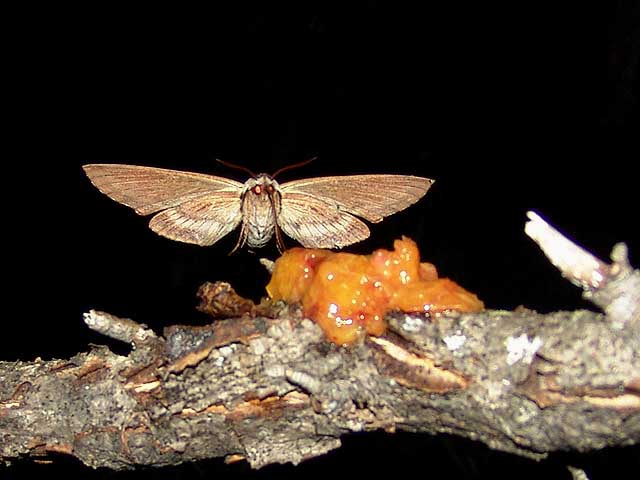
Sphinx kalmiae at bait, Peterborough, Ontario,
July 31, 2016, courtesy of Tim Dyson.
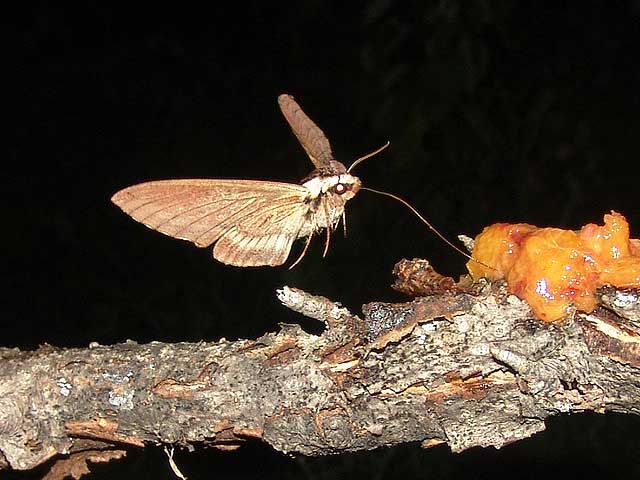
Sphinx kalmiae at bait, Peterborough, Ontario,
July 31, 2016, courtesy of Tim Dyson.
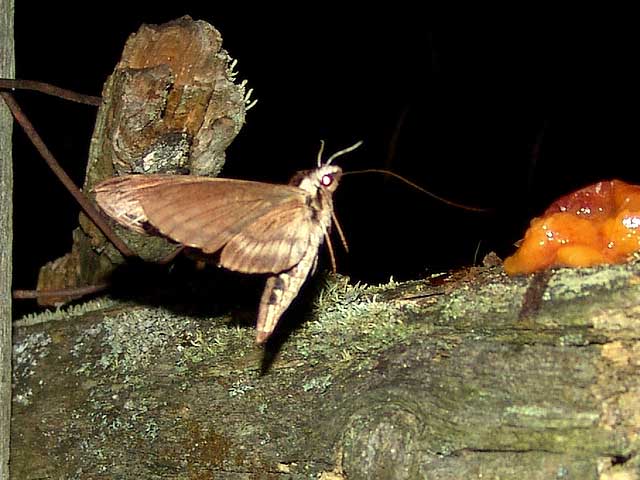
Sphinx kalmiae at bait, Peterborough, Ontario,
July 31, 2016, courtesy of Tim Dyson.
Tim also had a visit from Darapsa myron, same date, same fruit stand!
ECLOSION:
Little is known about the eclosions of the earth pupators, but many believe
pupae wiggle toward the surface just prior to emergence. Robert
Jindra reports that he has seen moths emerge from pupae within
subterranean chambers, climb out through the burrowing tunnel and
then climb to hang and inflate wings.
SCENTING AND MATING:
Kalmiae females extend a scent gland from the posterior of the abdomen
to lure in the night flying males.
EGGS, LARVAE, PUPAE:
Laurel Sphinx larvae feed primarily on lilac and
fringe. This day old larva is well camouflaged on the underside main lilac leaf vein.Larvae have also been found on privet.
Female Sphinx kalmiae don't seem to come to lights nearly as readily as males,
but when captured they will readily oviposit inside a brown paper bag. |
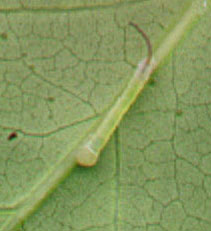 |
I remove the ova
with my thumb nail to a small, clear plastic hatching container and then move (gently with a spoon)
the hatchlings to a food container.
Lilac keeps quite well as cut food in buckets or lidded containers, and it is easy to rear most
Sphingidae indoors
on such cuttings, even in close quarters.
The fourth instar larvae to the right (courtesy of Tim Dyson--August 7, 2005) now has
some of the distinctive
markings and colouration of kalmiae and can consume several lilac leaves in a 24 hour period,
leaving just a
centimeter or two of leaf stem. Rearing quarters should be cleaned regularly, and
care
should be taken to avoid excessive humidity.
Note the "white leggings" above the "black boots" on the prolegs and the black
tip on the green "horn".
The fifth instar larva (below, courtesy of Tim Dyson) will leave
foliage in a day or so and crawl around the bottom of the container,
looking for soil in which to pupate.
| 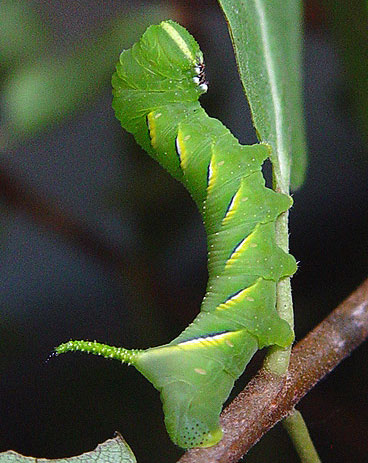 |
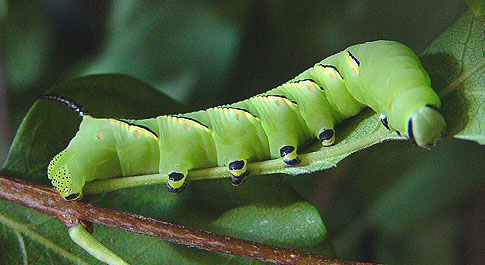
Fifth instar, note black on head, tail and on abdominal legs.
The anal horn is now blue with extensive black markinngs.
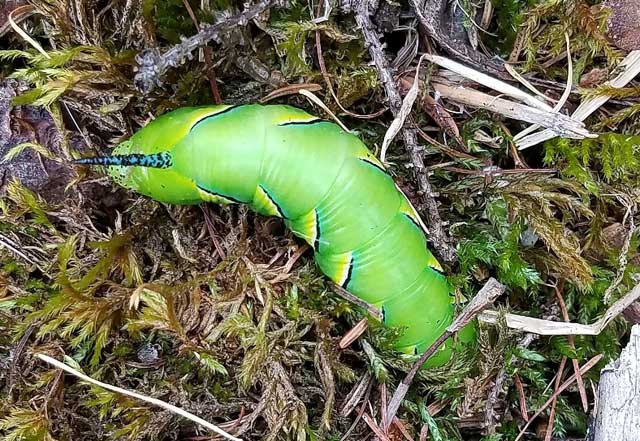
Sphinx kalmiae final instar, Barnum, Carlton County, Minnesota,
October 12, 2017, courtesy of Gary Walton.
Gary writes, "The laurel sphinx larva: photo on October 12, 2017,
burrowing into moss and forest duff in mixed spruce/balsam fir/aspen/birch forest at edge of alder thicket with black ash (Fraxinus nigra) trees."
Possibly there was some laurel or fringe in the undergrowth.
Visit Sphinx kalmiae fifth instar caterpillar, Marmora, Ontario, July 2009, courtesy of Damian MacSeian.
Visit Sphinx kalmiae, Apalachin, Tioga County, New York, July 11, 2012, courtesy of Colleen Wolpert.
Visit Sphinx kalmiae adult, Boone County, Iowa, MV light on small building on County Hwy R18,
July 28, 2009, Thomas Jantscher.
Visit Sphinx kalmiae, adult, Ozaukee County, Wisconsin, June 6, 2008,
Kate Redmond
I pick up
such Sphingidae larvae with my fingers and gently put them in a bucket, bottom-lined with several layers of
loose, dry paper towels. The larvae will crawl under the towelling and pupate
on the bottom of the bucket.
This method, a warm dark bucket lined with paper towelling, is
sufficient to induce pupation in most of the earth pupators.
Others use various mediums: leaf litter, peat moss, soil/sand mixes, etc.
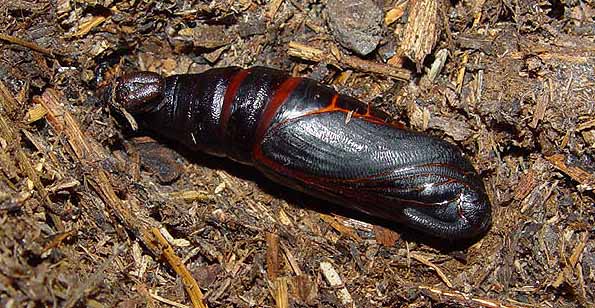
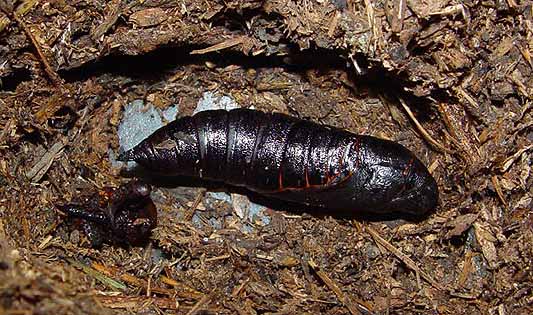
Sphinx kalmiae, pupae, Peterborough, Ontario,
courtesy of Tim Dyson.
The pronunciation of scientific names is
troublesome for many. The "suggestion" at the top of the page is
merely a suggestion. It is based on commonly
accepted English pronunciation of Greek names and/or some
fairly well accepted "rules" for latinized scientific names.
The suggested pronunciations, on this page and on other pages,
are primarily put forward to assist those who hear with internal
ears as they read.
There are many collectors from different countries whose
intonations and accents would be different.
In ancient Greek mythology the Sphinx was a unique creature with the
body of a lion, the wings of an eagle, and the head and breast of a
woman. It was vicious and single-minded.
The Sphinx sat on a high rock by a road near Thebes and posed a
riddle to all who wished to pass. The Sphinx strangled all who
could not answer its riddle.
"The name "Sphinx" derives from the Greek word
"sphingo," to strangle, or "sphingein," to bind tight, based on
the Sphinx's habit of strangling its victims. The name was
subsequently applied to the Egyptian and other arabic sphinxes
because of their physical similarity to descriptions of the mythical
Greek Sphinx."
Sphingidae larvae often strike a pose similar to that ascribed to
the "Sphinx", so possibly that has to do with the choice of the
genus name.
The species name "kalmiae" probably
originates from Pehr Kalm, an 18th century Swedish naturalist.
"Kalmia" is the genus name for various laurels. Moths may have
been seen nectaring at the flowers, or the golden colour of
the forewings might have suggested the "laurel wreathe" used to honour
"gold medalists".
Return to Sphingidae Index
Return to Sphingini Tribe













